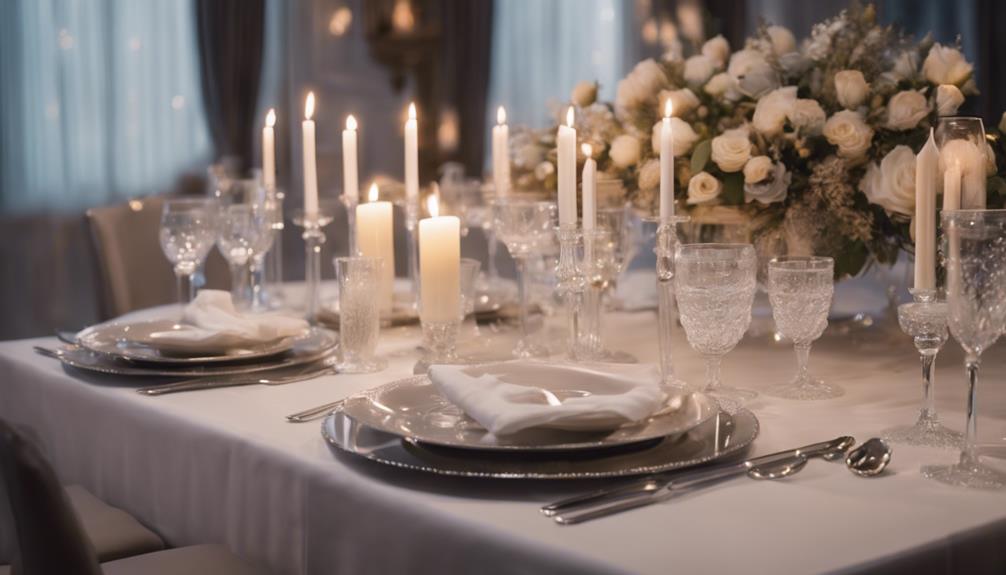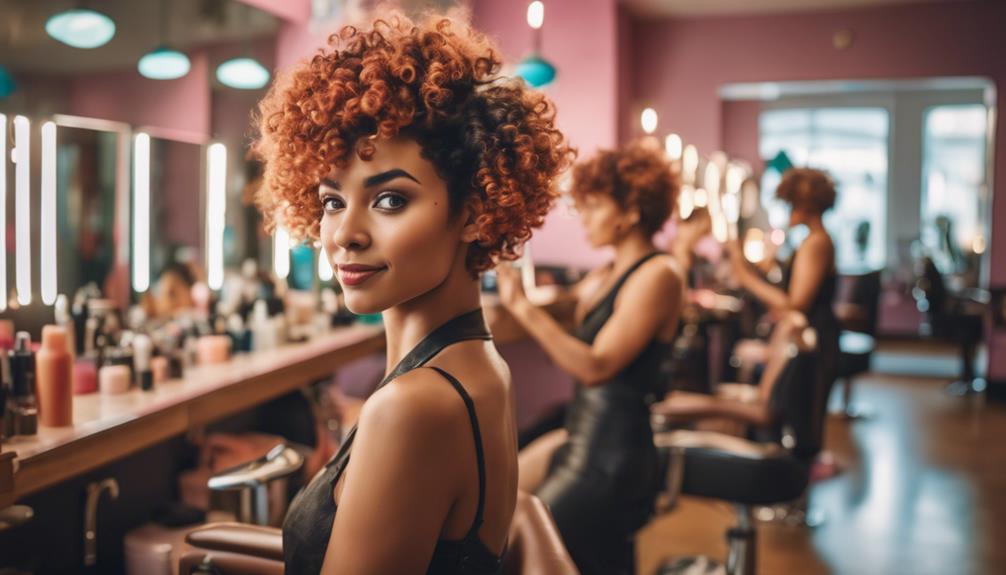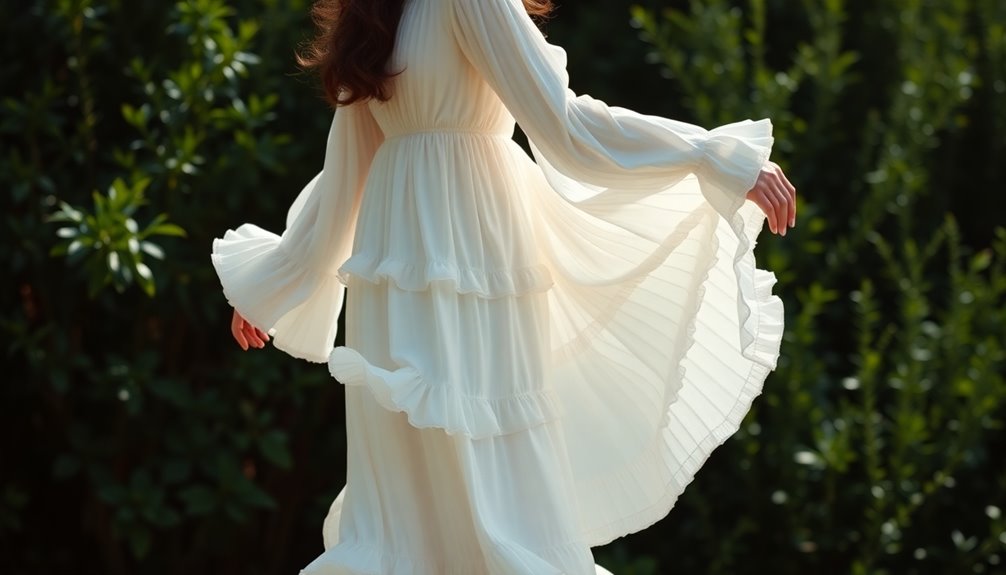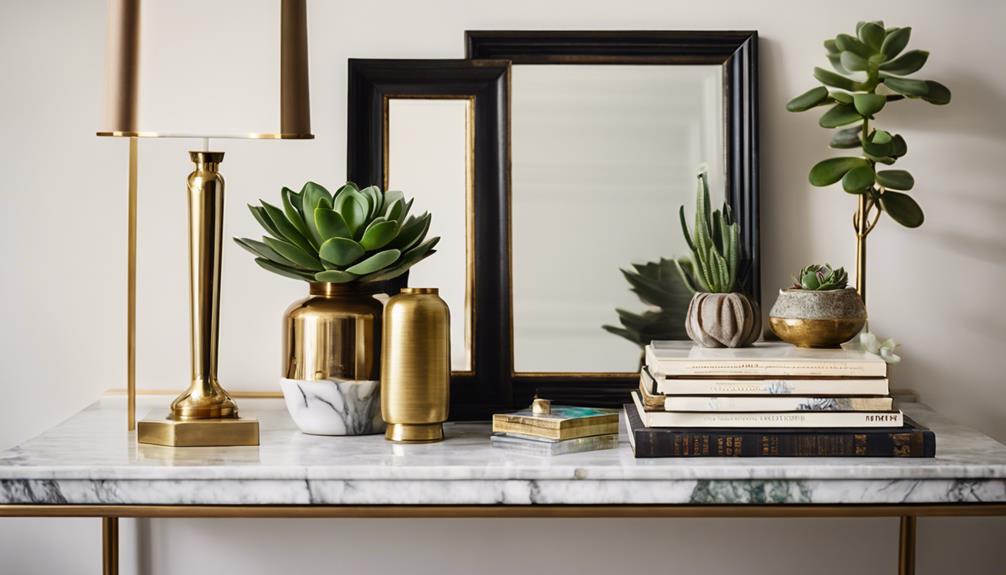Your dining area serves as the focal point for hosting elegant gatherings. Begin by selecting high-quality dinnerware and glassware, ensuring everything is polished to achieve that stylish look. A striking centerpiece, such as vibrant flowers or an artistic sculpture, can add a memorable touch. Consider incorporating a modern farmhouse style with reclaimed wood or opting for vibrant colors to invigorate the space. Do not overlook dramatic lighting; a stunning chandelier can enhance the overall ambiance. Experiment with mixing textures and patterns to create visual interest while maintaining cohesion. There are endless possibilities to uncover that can elevate your dining experience to something truly exceptional. When it comes to throwing a noteworthy dinner party, paying attention to the smallest details can have a significant impact. Explore incorporating some buffet styling tips to elevate your dining table even further. A thoughtfully curated buffet display can introduce an additional layer of sophistication to your entertaining area. Whether it’s incorporating varying heights with tiered trays or utilizing decorative serving platters, there are numerous ways to make your dining experience truly extraordinary.
Key Takeaways
- Incorporate metallic accents in tableware and decor to enhance elegance and create a modern yet warm atmosphere.
- Use a neutral color palette with natural materials for a modern farmhouse aesthetic that promotes a serene ambiance.
- Add unique sculptural elements or artistic centerpieces to draw attention and create a curated dining experience.
- Embrace vibrant colors and patterns in linens and decor to energize the space and encourage lively conversations.
Importance of Dinner Table Settings
Dinner table settings are essential for creating an inviting atmosphere that enhances your guests' dining experience. When you arrange your dinner table thoughtfully, it sets the tone for the occasion, influencing how your guests perceive the meal and the overall dining room feel. A well-designed table setting distinguishes between formal and casual occasions, making everyone feel comfortable and engaged.
Consider how a cohesive table setting can elevate the presentation of your food. By coordinating colors, textures, and styles, you not only showcase your culinary creations but also create a visual feast that excites your guests. This attention to detail encourages conversation, allowing everyone to engage more fully with one another.
Moreover, a beautifully arranged table leaves a lasting impression. Your guests will remember not just the meal but the ambiance you've created. Whether it's a simple gathering or a grand celebration, your dinner table serves as a focal point that enhances the entire experience.
Essential Elements of Table Settings

Creating an inviting table setting involves several essential elements that work together to enhance your dining experience.
First and foremost, you'll need quality dinnerware. This includes plates, bowls, and utensils, all arranged thoughtfully for ease of use. Position your glassware—whether for water, wine, or other beverages—above the knives, ensuring convenient access during the meal.
Next, consider the role of napkins. Whether you opt for cloth or paper, place them either on the plate or to the left of the dinnerware. This small detail adds an element of elegance while maintaining practicality.
A striking centerpiece, such as a floral arrangement or decorative item, serves as the focal point of your table setting, elevating the overall visual appeal. It draws attention and sets the mood for your gathering.
Lastly, don't overlook the importance of a tablecloth or placemats. These elements not only protect your table's surface but also unify the design by adding texture and color, creating a cohesive look.
Types of Table Settings
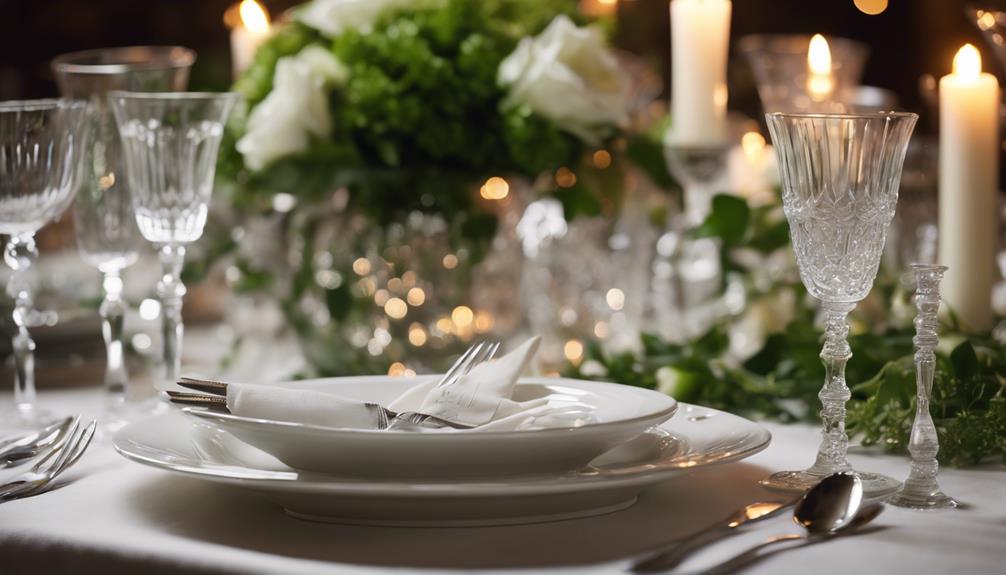
There are several types of table settings to contemplate, each designed to suit different dining occasions and atmospheres. Understanding these options helps you create the perfect dining experience for your guests.
| Type of Table Setting | Description | Best For |
|---|---|---|
| Formal Table Settings | Involves multiple courses, elaborate arrangements, and specific utensil placements, such as forks on the left and knives on the right. | Elegant dinners or special occasions |
| Casual Table Settings | Simpler setups with fewer utensils, typically just a dinner plate, fork, and knife. | Everyday meals or relaxed gatherings |
| Buffet Table Settings | Guests serve themselves with minimal settings, usually just plates and utensils at the start of the buffet line. | Large gatherings or parties |
| Family-Style Settings | Large serving dishes are placed in the center, encouraging sharing among guests. | Family dinners or gatherings |
| Themed Table Settings | Incorporates seasonal or event-specific decor, aligning the table's design with the occasion. | Holiday celebrations or themed parties |
Color and Design Considerations
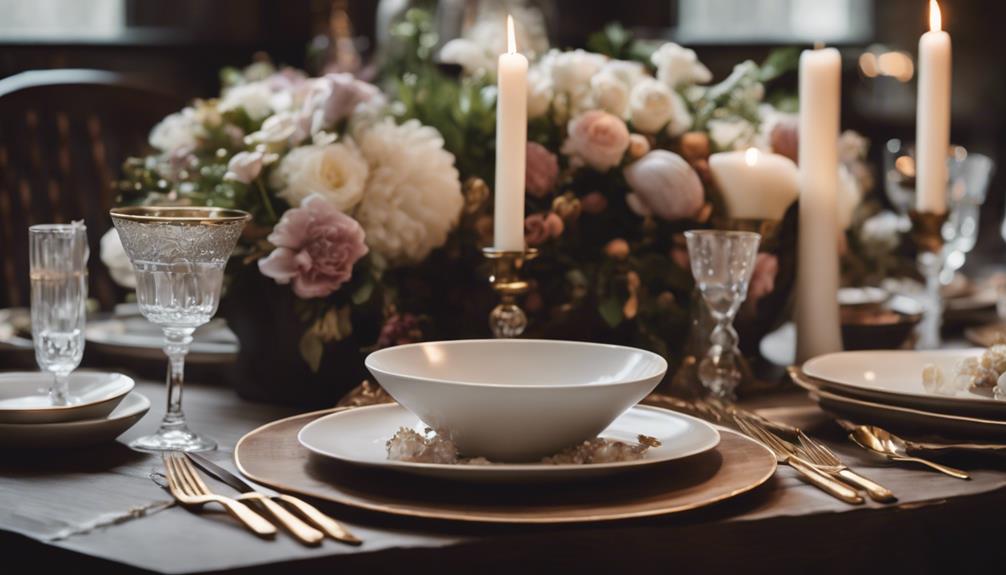
Color and design choices greatly impact the ambiance of your dining room, influencing how guests feel during their meal. When selecting a color palette, consider warm tones for a cozy vibe or cool tones for a calming atmosphere. Seasonal colors, like autumnal hues or spring florals, can also make your table setting feel timely and festive.
It's crucial to choose patterns that enhance your presentation without overwhelming it. Intricate designs can distract from the food, so opt for subtle patterns that complement your dishes. Textures play an important role as well; incorporating elements like linen napkins and wooden chargers creates depth and visual interest in your decor.
To achieve a polished look, guarantee cohesion among all elements of your table setting. This means matching your dinnerware's color palette with your tablecloth and centerpieces for a harmonious appearance.
Etiquette and Placement Guidelines
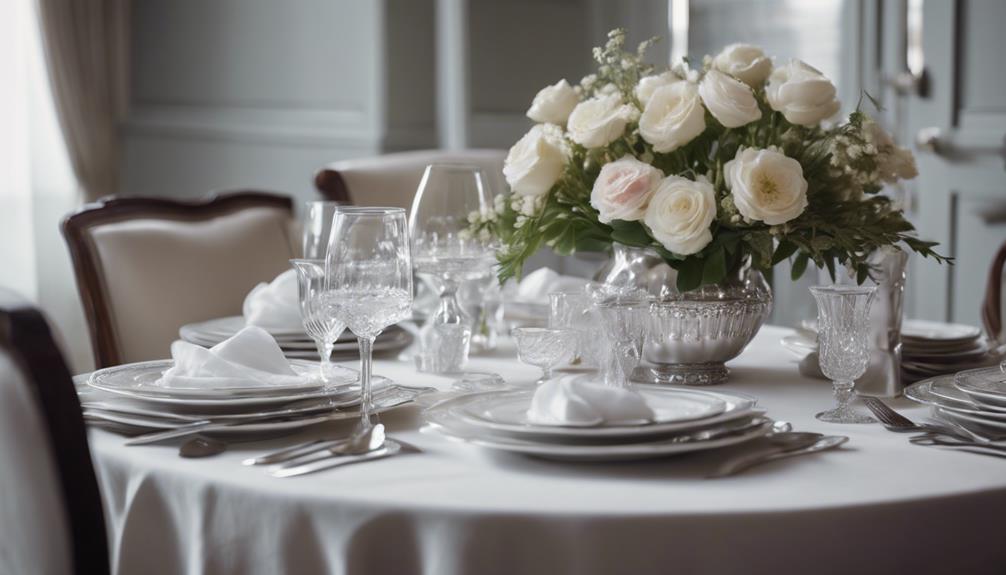
When setting your dining room table, proper utensil placement and glassware arrangement can make a big difference in your guests' experience.
You'll want to guarantee everything is easy to access, while also considering elegant napkin folding techniques to enhance the overall look.
Let's explore these key etiquette and placement guidelines to elevate your dining setup.
Proper Utensil Placement
Proper utensil placement is essential for creating an inviting and elegant dining experience. When setting your table and chairs for formal dining, remember that forks should always sit on the left side of the plate, while knives and spoons belong on the right, with knife blades facing the plate. This arrangement not only looks polished but also makes it easy for your guests to navigate their utensils.
For added sophistication, consider placing napkins either on the plate or neatly to the left of the forks, depending on the level of formality you wish to convey. If you're using place cards, they can guide guests to their assigned seats, enhancing both etiquette and the overall atmosphere.
Remember to keep the dining space tidy—clear away any used utensils before serving dessert or coffee. This helps maintain a refined appearance throughout the meal and encourages your guests to relax and enjoy the experience.
With these guidelines for proper utensil placement, you'll create a dining environment that reflects both elegance and thoughtfulness, making your gathering truly memorable.
Glassware Arrangement Tips
Arranging glassware thoughtfully is key to elevating your dining experience and guaranteeing guests can easily access their drinks. For a standard place setting, you'll want to include a water glass, a red wine glass, and a white wine glass. If you're serving sparkling wine or champagne, add a flute to the right of the white wine glass. This arrangement not only facilitates easy access but also contributes to an elegant presentation.
Here's a quick reference table for your glassware arrangement:
| Glass Type | Position | Notes |
|---|---|---|
| Water Glass | Above the knife | Essential for hydration |
| Red Wine Glass | Right of water | For red wine lovers |
| White Wine Glass | Right of red wine | Complements lighter wines |
| Champagne Flute | Right of white wine | For celebratory drinks |
| Matching Glassware | All glasses | Guarantees a cohesive look |
Always make certain the rims of all glasses are clean and polished to enhance the overall elegance of your table setting. Using matching glassware can create a sophisticated atmosphere, while varied styles can add a personal touch for casual gatherings.
Napkin Folding Techniques
Elevating your dining table isn't just about glassware; the way you fold and place napkins plays a significant role in the overall presentation and etiquette of your meal. For an elegant touch, consider using cloth napkins, which can be beautifully styled and reused, unlike paper alternatives.
Here are some essential napkin folding techniques and placement guidelines for a formal setting:
- Classic Fold: Simply fold the napkin in half and place it to the left of the forks for a timeless look.
- Pocket Fold: Fold the napkin into a pocket shape and place it on the plate, perfect for holding a place card or cutlery.
- Fan Fold: Create an elegant fan shape and position it in a glass for a striking centerpiece.
- Bishop's Hat: This intricate fold adds height and sophistication; place it centrally on the plate.
Incorporate Metallic Accents
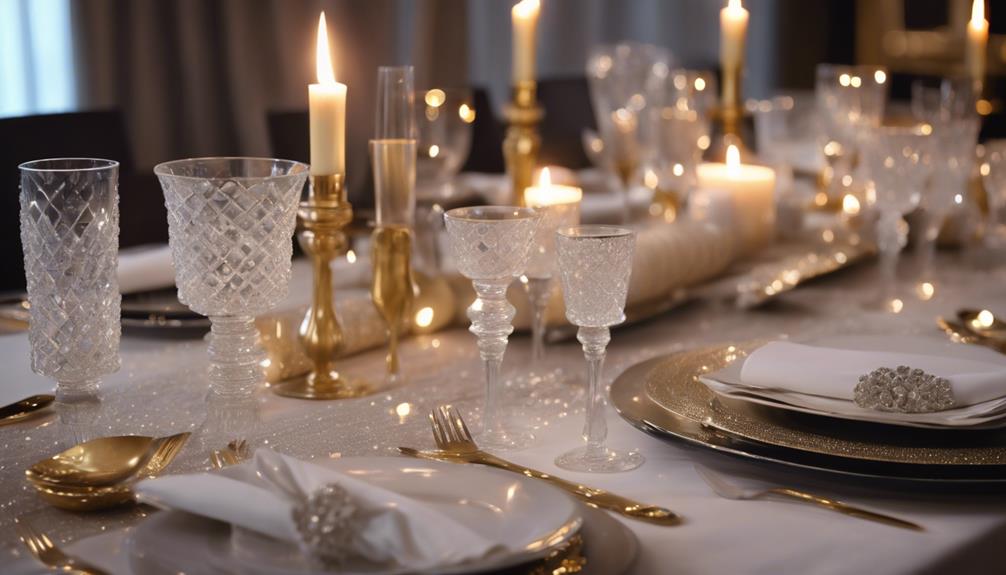
Incorporating metallic accents into your dining room not only creates a stunning focal point but also enhances the overall elegance of the space. Consider using shiny copper pendant lights to draw the eye and add a touch of warmth. Reflective elements, like polished silver or gold tableware, can elevate your dining experience, making the table not just functional but a statement piece.
When exploring decorating ideas, think about mixing different metallic finishes, such as brass and chrome. This layered approach adds depth and personality to your table setting, making it visually intriguing. You might even consider bold art pieces with metallic frames to contrast against clean-lined furnishings, providing a modern twist to your traditional decor.
Modern Farmhouse Aesthetic
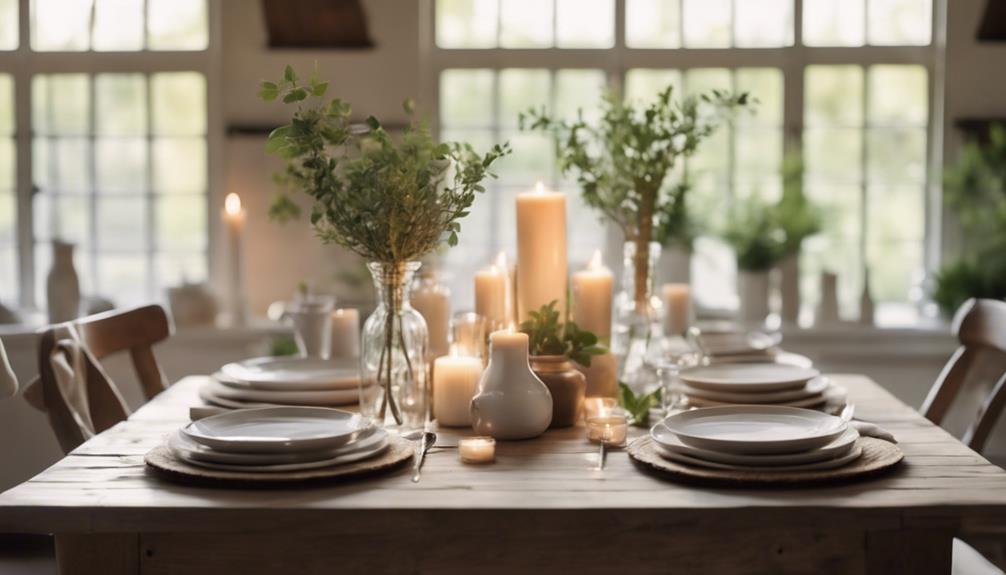
While metallic accents add glamour to your dining space, the modern farmhouse aesthetic brings a warm, rustic charm that feels inviting and relaxed. To create this cozy atmosphere in your dining area, focus on a few key elements:
- Reclaimed Wood Dining Table: Opt for a sturdy, reclaimed wood dining table that serves as the centerpiece and adds character.
- Wishbone Chairs: Incorporate wishbone chairs to bring elegance while maintaining a casual vibe; they're perfect for both everyday meals and special gatherings.
- Neutral Color Palette: Embrace neutral colors like soft whites, grays, and beiges to enhance the serene ambiance, allowing other elements to shine.
- Natural Elements: Integrate natural materials like jute and cotton through table runners and placemats to add texture and warmth.
Don't forget to accessorize with vintage tableware and handmade centerpieces that reflect your personal style.
Layering these textures and elements will elevate your dining table setup, creating an inviting space perfect for entertaining friends and family in true modern farmhouse style.
Sculptural and Artistic Elements
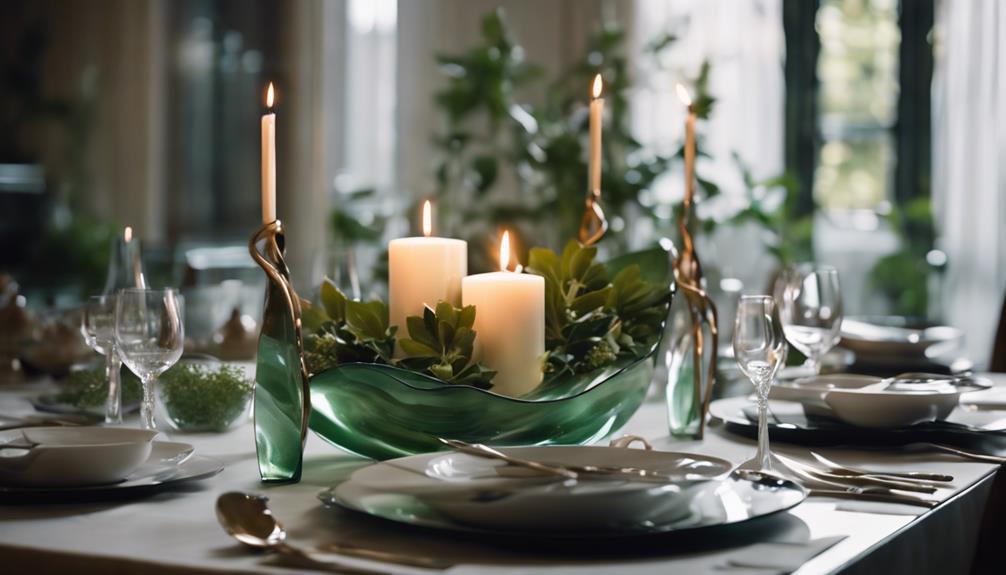
Sculptural and artistic elements can transform your dining table into a stunning focal point that sparks conversation and enhances your overall decor. Incorporating unique sculptural elements, like an artistic centerpiece or a striking glass vase, draws the eye and adds depth to your table setting. Opt for a glass vase filled with natural branches or seasonal florals to introduce organic shapes that contrast beautifully with the linearity of your table.
To elevate your dining experience, choose upholstered dining chairs that not only add sophistication but also guarantee comfort. This encourages your guests to linger and enjoy their time together. You can also display small sculptural objects alongside functional items, creating a curated look that showcases your personality and style.
Don't overlook the importance of decorative accents on sideboards. Layering art, books, and other accessories alongside your dining table can enhance the overall aesthetic, making the dining room feel more inviting.
Vibrant and Colorful Decor

Bringing vibrant colors into your dining room can instantly lift the mood, creating an inviting atmosphere that encourages lively conversations and memorable gatherings. To achieve this, consider the following ideas for incorporating vibrant decor:
- Bold Color Choices: Use drapes, wallpaper, or art in bold hues to energize the space. A striking accent wall can serve as a fascinating focal point.
- Mix Patterns: Combine various patterns in your table linens and decor. This free-spirited design approach adds character while embracing vibrant colors.
- Seasonal Decor Elements: Incorporate seasonal decor elements, like bright flowers or themed tableware, to elevate the ambiance. These seasonal touches create a fresh and festive vibe.
- Vibrant Tableware: Opt for colorful plates and napkins that create a striking contrast against more neutral table settings. This draws attention to the dining experience and enhances the overall aesthetic.
Dramatic Lighting Fixtures
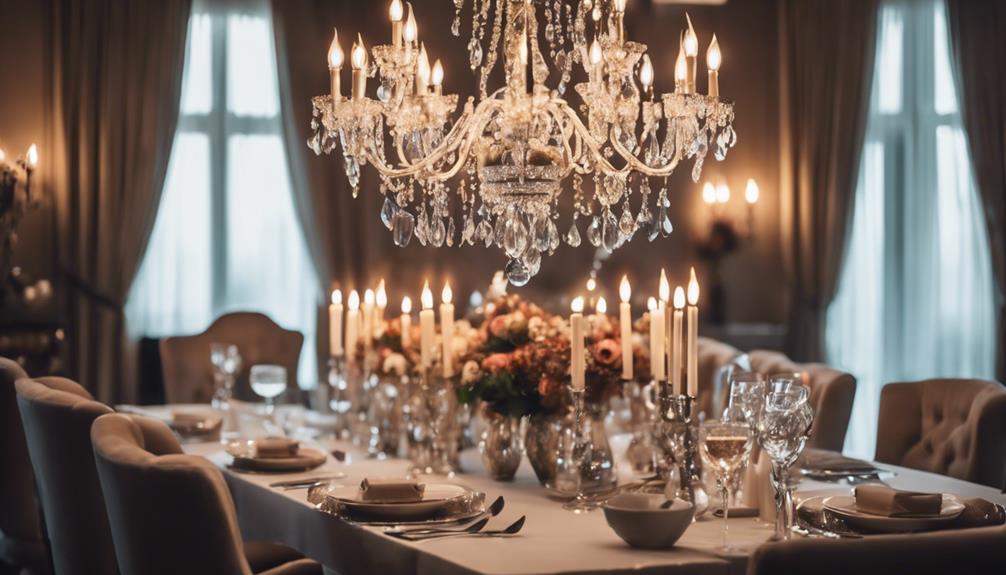
When it comes to setting the mood in your dining room, dramatic lighting fixtures can make all the difference.
You'll want to choose the right fixture that not only enhances the ambiance but also complements your decor.
Think about how different styles and brightness levels can transform your space for various occasions.
Impact on Ambiance
Dramatic lighting fixtures can transform your dining room, creating an enchanting focal point that enhances the overall ambiance. Choosing the right lighting not only elevates the aesthetic but also sets the mood for your gatherings.
Here are four key considerations for maximizing the impact of your lighting:
- Statement Pieces: Opt for oversized pendant lights or ornate chandeliers that serve as eye-catching elements, drawing attention to your dining table.
- Warm vs. Bright: Use warm-toned bulbs for a cozy atmosphere or brighter fixtures to energize the space, depending on the occasion.
- Layering Light: Incorporate a mix of ambient, task, and accent lighting to create versatility, allowing you to adjust the ambiance for both casual meals and formal events.
- Reflective Surfaces: Choose fixtures with glass or metallic finishes to amplify natural light and create a sense of spaciousness within your dining room.
Choosing the Right Fixture
Choosing the right lighting fixture can elevate your dining room's style and create an enchanting atmosphere for your gatherings. Oversized pendant lights, for instance, can serve as striking focal points, enhancing both aesthetics and ambiance. If you want to encourage a bright and inviting dining experience, consider airy light fixtures that improve the flow of natural light throughout the room.
For an elegant touch, dramatic lighting options like antique chandeliers can add sophistication, perfectly complementing traditional dining settings. These fixtures not only illuminate but also become conversation starters, making your dining experience memorable.
If you prefer a more modern approach, incorporating wood fixtures can provide a semi-transparent sculptural element that blends seamlessly with various design themes while adding warmth to the space.
Frequently Asked Questions
How Do I Make My Dining Table Look Elegant?
To make your dining table look elegant, use a rich tablecloth or placemats, high-quality dinnerware, and a striking centerpiece. Arrange utensils properly and layer textures for depth, creating an inviting atmosphere for your guests.
How Do You Set up an Elegant Dinner Table?
Setting up an elegant dinner table's like crafting a masterpiece! Start with a stunning tablecloth, arrange dinnerware meticulously, fold napkins artistically, and place an enchanting centerpiece to elevate your dining experience and impress your guests.
What Do You Put in the Middle of Your Dining Room Table?
You can put an eye-catching centerpiece in the middle of your dining room table. Consider using flowers, candles, or decorative bowls. Varying heights and groupings in odd numbers create visual interest and elegance.
How Do You Decorate a Formal Dining Table When Not in Use?
To decorate a formal dining table when not in use, you'll want to layer a beautiful tablecloth, arrange chic centerpieces, and display elegant dinnerware. Adding personal touches will really showcase your style and create an inviting atmosphere.
Conclusion
So, while you might think a beautifully styled dining room table is just for show, it's actually your secret weapon for elevating any gathering.
Just imagine your guests marveling at your impeccable taste, all while they're blissfully unaware of the chaos happening in the kitchen.
By embracing these styling ideas, you're not just setting a table; you're setting the stage for unforgettable moments—even if the main course ends up being takeout.
Cheers to elegance in entertaining!
